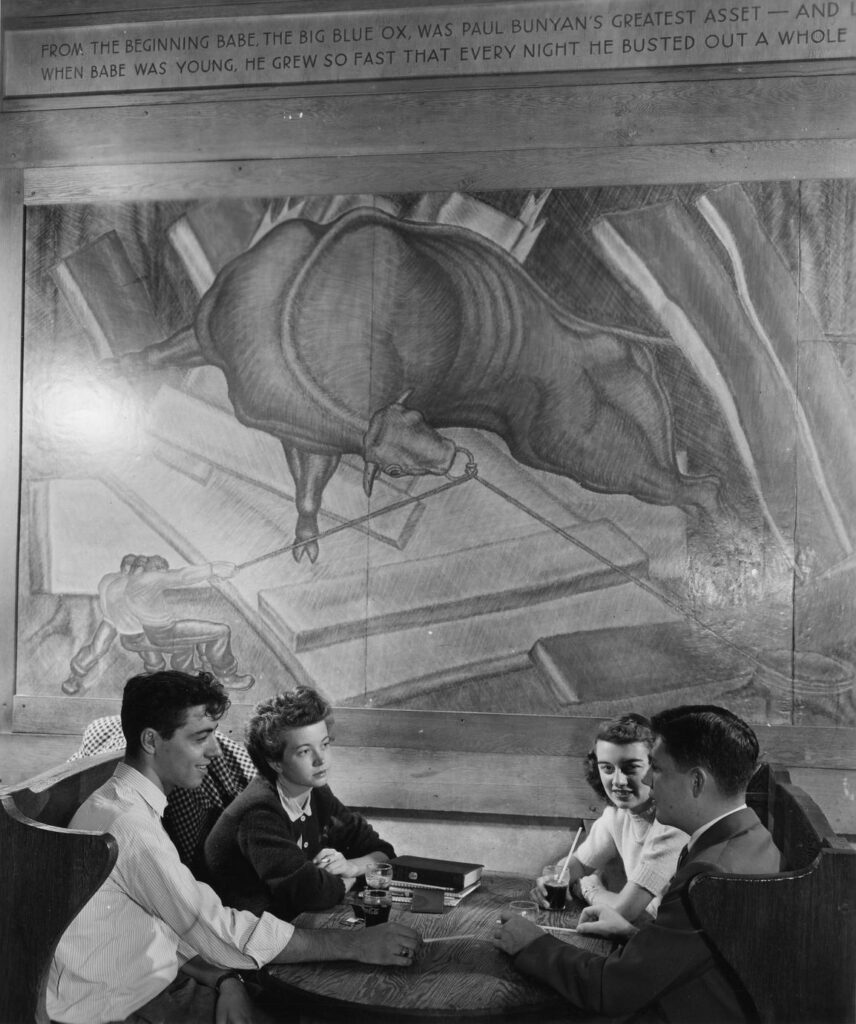Stories From Before the First Fifty Years
Art History Professor James Watrous left his mark on the UW campus in myriad ways, as a student, educator, and even an artist. But his biggest legacy, though it doesn’t bear his name, is made of stone.

Millard Rogers, left, and James Watrous on the construction site ca. 1968
Late in 2018, a beloved 40-piece mural set depicting Paul Bunyan and his enormous blue ox returned to Memorial Union, installed in a room now bearing the folk hero’s name. The mural, which was taken down in 2012 in preparation for the renovation of Memorial Union, is well-loved by students, faculty, and visitors, although many might by now be unfamiliar with the man who painted it more than 80 years ago while a graduate student at the university.
Watrous, who died in 1999 at the age of 90, was an institution on the University campus, a muralist and painter, art historian and scholar of printmaking, and advocate for incorporating the arts into university life, a goal that he eventually help realize with the construction of the Elvehjem Art Center (now the Chazen Museum of Art) in 1970. Born in 1908 in Kansas, Watrous first joined the University of Wisconsin-Madison as a student in the 1920s, going on to earn his bachelor’s, master’s and doctorate working under art history professor Oskar Hagen, and was quickly hired as a professor of art in 1935.[1] Watrous was drawn to the UW in part because of its unique (at the time) interest in opening the campus to young artists, including its hiring of noted regional printmaker John Steuart Curry as an artist-in-residence in the College of Agriculture in 1936.
Watrous left his artistic mark on other campus sites as well. To the left of the inside entrance to Memorial Library is a vibrant Byzantine gold mosaic, composed of glass and colored smalti imported from Murano entitled, fittingly “The Library.” The mosaic, meant to convey in images of constellations and ancient elements the task of all libraries to preserve modes of human perception, was completed by Watrous in 1977.[2]
In the midst of teaching, researching, and creating artwork such as the “The Library,” and the Bunyan mural, Watrous was also working behind the scenes to leave his biggest mark on the face of the UW campus – a university art center. While working as a professor in the 1930s, Watrous and one of his graduate students were dismayed to discover a large portion of the university’s collection of art, including several valuable paintings, languishing in the humid basement of Bascom Hall. Watrous became convinced that the UW was in dire need of a permanent center – a laboratory, as he imagined it – where art might be exhibited and available to all departments and students on campus for research, teaching, and study. He also immediately began trying to convince UW Presidents Fred Dykstra, Fred, and finally Elvehjem that the university had a responsibility to either begin raising funds for a museum, or to cease its haphazard collection of art. As Watrous remembered:
“I sat down as a bumptious young instructor and wrote a letter to then-President Dykstra, indicating my dismay and the desirability of having a proper place to house these paintings so that people could enjoy them if nothing else. And I guess that was a beginning of a great many years of just kind of nudging and trying to persuade people that cultural facility like the Elvehjem Museum would be a very desirable resource for an educational institution.”[3]
After many frustrating years of nudging, sometimes elbowing, administration, Watrous was finally victorious. President Conrad Elvehjem, the building’s namesake, agreed to put the question to a faculty vote, and Watrious successfully lobbied enough to vote in favor of the project, convincing them that it would be a boon to the entire university and community, not just the applied arts and art history departments. When Elvehjem, a chemist by training, died in office of a heart attack, his successor Fred Harrington decided to name the forthcoming art center in his honor. In 1963, following an historic donation of one million dollars from the Brittingham family fund, the Wisconsin Foundation agreed to large-scale fundraising for the art center. And Watrous’s work did not end with the faculty vote; instead, he worked tirelessly to help raise funds, finesse relationships between the university and donors, and ultimately help brainstorm building plans for the art center with famed Chicago-based architect Harry Weese. (Watrous himself had drafted six different plans for the museum, though they were never used.)[4] Groundbreaking for the museum finally took place in October of 1965 and was finally completed five years later. Though the massive space bears the name of Conrad Elvehjem, it is the spirit of Watrous that lives on in in every stone and skylight. “…[T]he appreciation of art in a broader view can be looked upon much as the appreciation of literature. Good literature or good music, and if we take the latter, which is seemingly a more public thing…the appreciation of fine music depends upon one’s opportunity to experience it… As a resource for the university [the museum] must serve as effectively as possible. Whatever it can do for the public beyond that…that’s great.”[5]

Students in the Paul Bunyan Room in 1950 in Memorial Union, sitting in front of James Watrous’s mural of Bunyan and his ox, Blue, painted between 1933 1936 (UW-Madison Archives)

James Watrous in front of his mosaic for Memorial Library, 1977 (UW-Madison Archives)
[1] Murphy, Thomas H., (ed.), “The Visible Legacy of James Watrous,” Wisconsin Alumnus (vol. 77, No. 5, July 1976), 7-9.
[2] Watrous, James (1908-1999), Oral History Program interview with James Watrous, 1976, Madison: University of Wisconsin, 1976.
[3] Watrous, James (1908-1999), Oral History Program interview with James Watrous, 1976, Madison: University of Wisconsin, 1976.
[4] Ibid.
[5] Ibid.